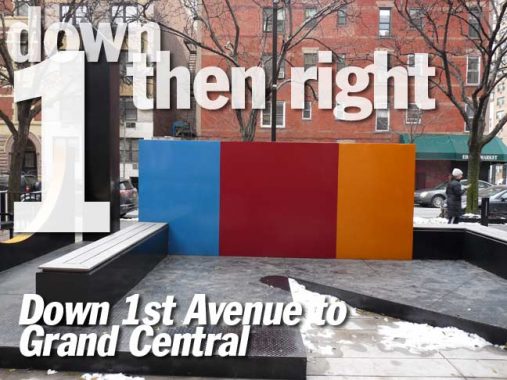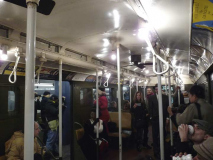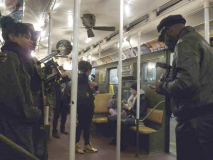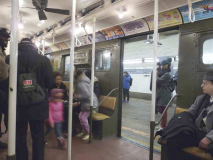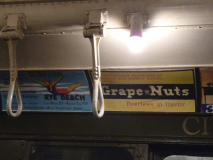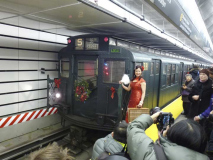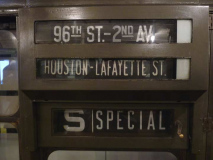As I usually do in December I rode the MTA’s “holiday special” trainset, which is a unit of older cars that the Transit Museum put together from its vintage car collection. The set ranges from the early 1930s to the early 1960s. Generally, I like to ride the R1/R9s, introduced in the early 1930s to run on the then-new Independent Subway, whose 8th Avenue Line opened for business in 1932. The subways were unified under one agency by NYC in 1940, but the IND continued to add a few stations after that to its 6th and 8th Avenue, Grand Concourse and Queens Boulevard lines. Since 1950, the subways have nearly been in stasis, with only a handful of new stations, and 2nd Avenue the only new trunk, with service beginning 1/1/2017.
The MTA and the Transit Museum did something different for the holiday specials, which ran each Sunday between Thanksgiving and Christmas. Formerly the special ran between 2nd Avenue and Houston Street and Queens Plaza, following the F and E lines. Taking advantage of a new connection at 63rd Street, the special began at 2nd Avenue in the Lower East Side as usual, and switched to the Second Avenue Line, terminating at 96th Street.
In addition to riding in the R1/9 (as I understand it the R simply stands for “revenue”) cars and enjoying the olive green paint scheme; relatively dim incandescent lighting (fearing crime, modern subway cars are blue and white and bathed with near-blinding white light, so they resemble doctors’ or dentists’ offices); wicker seating that women said ruined their stockings in an earlier age when they didn’t wear pants so often; and various mechanical noises that made clear you were riding a railroad — changes in subway cars have evolved since then toward the greater good, I am aware — I decided to take advantage of this relatively easier way to reach the Upper East Side and walk down 1st Avenue then west to Grand Central Terminal, mainly since I have managed to avoid 1st Avenue till now, not because of any bad reputation I may have heard about but simply because — it was more difficult to get to.
Scenes from inside the R-1. As is usual, there were people dressed in 1930s and 1940s outfits, which makes the crowds on these holiday specials an odd mix of costumed hipsters, foaming teenage rail fan boys (the genre includes few females) and relatively normal people like myself, scuttling about with cameras. Some of the outfitted people took it all they way and brought vintage flashbulb cameras. (Even I am getting to look old fashioned because I still use a Panasonic Lumix, whose battery runs out much more slowly than an IPhone camera will).
A new Miss Subways meets the paparazzi. Actually, take a look at the roll signs. Some new ones were produced in the MTA sign shop to be specifically used for this new route, indicating the 96th Street terminal. A nice touch, but I said, “This, they’ve got money for”? Weekend service is seemingly ineluctably tied up with necessary maintenance of way, and there never seems to be enough money or time to finish it.
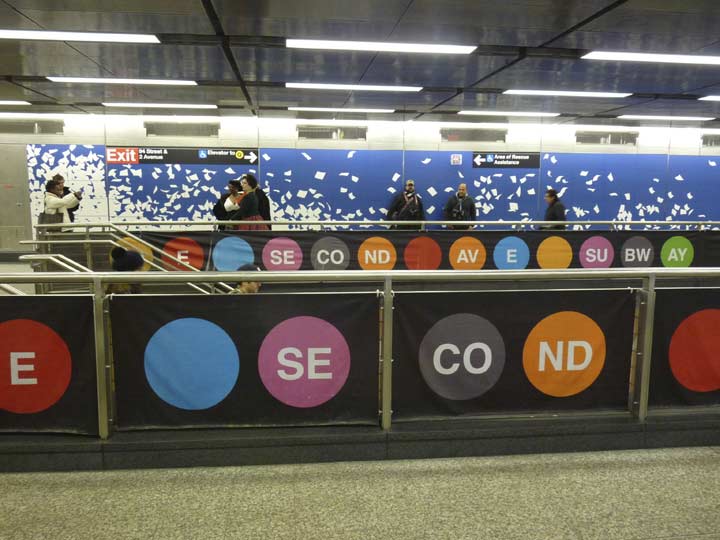
Frankly, I think it’s time for the MTA to remove these kandy-koated banners from the railings of the new Second Avenue Subway stations; they look a bit garish, especially compared to the otherwise austere white palette that was used, interspersed with the art you see on the background wall.
A year ago (January 2017), I walked Second Avenue and took a thorough look at its new subway stations.
What the Second Avenue Line has done is bring back elaborate entrance kiosks, which, when the original IRT built them in 1908 where heavy iron structures (meant to resemble similar ones in Budapest, Hungary) with different designs for entrances and exits. They were built close to the sidewalks and so impeded auto sightlines when the Auto Age began around 1920, and thus. most were removed by the late 1960s. New ones are glassy and airy, and most are not set up at curbs.
From the station, I walked east on East 94th and was immediately greeted by a classic black plastic-lettered sign, “Telesca-Heyman.” I had to get close to see it, as an adjoining building is obscured by a sidewalk scaffold (which last almost forever). Telesca-Heyman is a cabinet manufacturer and repairer, which also does reupholstery work.
You can pretty much find anything you want in NYC and you can pretty much operate any kind of business you want, provided you have enough money to keep up with the exorbitant rents. I passed this storefront at #308 West 94th and found all manner of interesting knickknacks* in the window of the George Glazer Gallery, which specializes in antique globes and maps. It was closed on this Sunday, but a look online finds a quirky place chockablock with collector’s items.
The gallery and its eccentric owner have been featured on numerous television programs including episodes of “Martha Stewart Living” and PBS’s antiques show “Find!” Pieces from the gallery have appeared in magazine and newspaper articles nationwide and are often chosen as centerpieces by professional decorators. [Atlas Obscura]
*The only word in English I can think of with a silent double k
This pair of walkup buildings on East 94th off 1st Avenue seem to have a timeless design next to the monstrous high rises on 1st, which were built in the 1970s and 1980s and look like it.
Trundling south on 1st Avenue now, I was attracted by this storefront display for the Mellow Yellow coffee shop, 1729 1st Avenue north of East 89th not least because yellow is one of my favorite colors. The shop also sells hot food specializing in Middle Eastern. The exterior is festooned with pans, with the logo rendered in Baskerville Italic. The title of the 1966 hit record by Donovan was not inspired by smoking banana skins as Country Joe McDonald has averred, but instead by women’s vibrators, or “electrical bananas.”
On to our next item…
We’ve seen Glazer’s….here’s Glaser’s Bake Shop at 1st and East 87th, which has been here for over a century. I was so taken by the history of this bake shop, I posted an item about it in December 2017. I have to stay away from bake shops, as my blood sugar dictates.
I was attracted by this outdoor pedestrian plaza at 401 East 80th Street at 1st Avenue, Gracie Mews, which is named for the 18th Century Gracie Mansion at East End Avenue, which has been the NYC mayor’s residence for several decades. I liked the bold color panels in primary colors. Officially, it’s known as Steel Park and was assembled in 1980, when the high-rise was constructed. Its artist was Tony Rosenthal (1914-2009), who is best known for two other NYC works: Alamo, the revolving cube at Astor Place and Cooper Square (1967), and 5 in 1 (1973) outside Police Plaza behind the NYC Municipal Building.
There’s a flock of public street clocks on 1st Avenue in the East 70s. This first, at East 79th Street, can be found on a former bank building, now a vitamin franchise; the clock undoubtedly dates from the bank presence. It still tells time.
Another one, at East 75th and 1st Avenue, is athe property of The Saratoga high-rise tower, constructed in 1984; it has the same design as street clocks of yore from the early 20th Century.
Another clock overlooks the sidewalk across the street at the uptown location of the Second Avenue Deli. The numbers are apparently rendered in Hebrew characters, but if anyone can translate, give me a shout in Comments. The original Second Avenue Deli was at 2nd Avenue and East 10th in the East Village, but closed and later moved uptown after owner Abe Lebewohl was murdered during a robbery. The original Second Avenue Deli neon sign can be found in Williamsburg’s City Reliquary.
Yet one more clock, this time nonfunctioning, at another former bank building (now a branch of Sloan Kettering Memorial Cancer Hospital) above the front entrance at the NW corner of 1st and East 74th Street.
I’m unsure how long the exquisite stained glass panel work at wine bar In Vino Veritas (Latin for “in wine there is truth”) at 1375 1st Avenue at East 74th has been in place, but it’s masterful, no matter the age.
It’s Bareburger, not Bearburger, on 1st and East 73rd, But you never know. I only had one meal at a Bareburger, in Hoboken in late 2016, and stuck to what I knew on the menu. I’ve been to places where they served kangaroo.
There are new stanchions at bus stops that tell you when the next bus is coming, ‘lectronically. If you want the M15, looks like you just missed one and have a 15 minute wait. So far, these posts are being installed sparingly, though interestingly, the first ones I found were in Staten Island. The fluted bases remind me of pre-1965 stoplights (which got boxy bases after that year). You can press a button if you are sight-impaired, and a voice will tell you how long the wait will be.
It’s all in the incredible details at St. John Nepumocene Roman Catholic Church at 1st Avenue and East 66th, a Romanesque classic constructed in 1925 [John Van Pelt, arch., who also designed Guardian Angel Church on 10th Avenue in Chelsea. Check out all the faces! The four Gospel authors, Matthew, Mark, Luke and John, are also present in their symbols: angel, lion, ox and eagle. Its namesake, John of Nepomuk, was martyred at the behest of “good king” Wenceslaus in what is now the Czech Republic in 1393.
I can’t vouch for the service at Goldberger’s Pharmacy at 1st and East 65th — which was closed on Sunday, what if you need a prescription? but it’s still got some magnificent neon. The Indispensable Walter Grutchfield has a photo of the neon lit up in red and green. The shop was founded by Aaron Goldberger in 1908, and had moved to this location at #1200 1st Avenue by 1915. Some sources say the neon dates to 1960 (I make it earlier than that) and the shop’s website claims it was founded in 1898; I trust Grutchfield. The buildings here on the east side of 1st Avenue were a suburban development from 1898, in an era when this area was indeed suburban.
There had been a painted ad on this brick apartment on the SE corner of 1st and East 64th, but by now it’s too faded to discern.
The Baker Street Pub, at the NE corner of East 63rd and 1st Avenue, features silhouettes of the classic deerhatted image of Sherlock Holmes, originally played in the movies by Basil Rathbone, though latterday Holmeses played by Robert Downey Junior, Benedict Cumberbatch, and Jonny Lee Miller have come to the fore in the last decade, the detective has been played by dozens of actors. 221B Baker Street was Holmes’ address in the Arthur Conan Doyle stories. Street View allows you inside.
Dangerfield’s, #1118 1st Avenue near East 62nd street, was co-founded by the “can’t get no respect” Kew Gardens comic Rodney Dangerfield in 1969.
The Queensboro Bridge overpasses 1st Avenue at East 60th Street on magnificent masonry arches constructed between 1905 and 1909. Beneath the 1st Avenue arch, the roof is lined with interlocking tiles by Spanish architect Rafael Guastavino (the restaurant/caterer here is named for the architect). A Food Emporium suprmarket also occupies space below the span.
The forbidding-looking Terence Cardinal Cooke Building, 1st Avenue and East 56th Street, is named for the former Archbishop of New York between 1968 and his death in 1983. The black glass tower was completed in 1979 and serves as the headquarters of the Catholic Archdiocese of New York.
As my goal was Grand Central Terminal, I headed west on East 53rd. I can never resist highlighting the pair of woodframe buildings at #312 and #314 East 53rd near 2nd Avenue, both constructed by Robert and James Cunningham in 1866. The rest of the block is dominated by brownstone and brick buildings from about 20 years later, and new construction of woodframes was outlawed in Manhattan later on because of the fire risk.
Directly across teh street is #307 East 53rd, is the Tanzania Mission to the United Nations. The African nation purchased for former “Timekeeper Building” in 2011. You might think it was originally a clock or watchmaking factory, but the 1886 building originally produced cigars; I don’t know why it acquired the nickname.
A pair of bars on 2nd Avenue at East 53rd, Redemption Sports Lounge and Turtle Bay New York City, are Redskins and Eagles bars, respectively. As of this writing the Eagles were still involved in the playoffs.
The 42-story Dag Hammaskjöld Tower, 240 East 47th Street, displays a replica bust depicting the Secretary General sculpted by Carina Ari (1897-1970). Read all about it on this FNY page.
2nd Avenue and East 45th Street. The Matto pizzeria was formerly a Blimpie’s, where I would have lunch once a week, around 2 AM, mostly on Thursdays, from 1982 to 1988. That time is correct. I was employed on the “lobster shift” at Photo-Lettering, the biggest type shop in the city: it not only produced and set type, mostly for Madison avenue advertising firms, but designed type fonts, some by Ed Benguiat (pronounced BENG-gat) one of the biggest names in the type biz. No doubt the Blimpie’s was open 24/7 to accommodate some of the type shops in the area, which produced the type for ads overnight that needed to be on the advertisers’ desks by 9 AM. I worked hard, but was poorly paid, but there was healthcare and benefits.
I suppose I can be nostalgic about anything. One of my first jobs out of school was as a proofreader and typesetter at Photo-Lettering, 216 East 45th. It was sometimes boring work that divided incredibly productive and feverish labor with other times when there was nothing to do, the clock moved like molasses, it’d be 1AM and I wondered what I was still doing there.
Changes were afoot that would make Photo-Lettering and its processes irrelevant, however, as the desktop typesetting process, in which everyone is in effect their own typesetter, was on the way. PL sold all of its font collection and was gone in a few years after I left for a daytime job in 1988. I wrote about my experiences for SpliceToday and also on FNY’s Photo-Lettering page. The experience was very formative for me.
I’d like to know the history of this low brick building on East 45th just west of 2nd Avenue. It’s currently occupied by an Amish Market franchise.
One of the oldest buildings on East 45th between 2nd and 3rd, home to a sushi joint, next to the Comfort Diner, which was an eatery when I was working on the block in the 1980s. Across the street is The Perfect Pint, formerly the Pen & Pencil steakhouse, where Hunsecker/Winchell-esque New York Post columnist (though nicer) Earl Wilson once held forth from there. “That’s Earl, brother” was his catchphrase; the restaurant was sold in 1998. It was mentioned in the TV show Mad Men, set in the 1960s ad world in NYC: According to Eater.com, “While waiting for Don to show up to a meeting, Freddy Rumson complains about “not being at the Pen and Pencil by 12:30.” I’m surprised Draper never mentioned Photo-Lettering!
The Graybar Building abuts Grand Central Terminal as well as the Grand Hyatt (formerly Commodore) Hotel on Lexington Avenue across the street from the Chrysler Building.
Above one of the entrances at 43rd Street at Lexington, a handsome canopy protects people waiting for taxicabs. But what are those bumps on the struts holding the marquee in place? Those aren’t bumps–those are rats! What in the world are carved rats doing on a NYC building: haven’t we got enough real ones? A close look will also reveal eight rats’ heads surrounding each hawser (the lines holding the canopy) as they reach the Graybar Building.
The Graybar was originally named the Eastern Offices Building. It was designed by the architectural firm of Sloan and Robertson and opened in 1927, at the height of the Art Deco period, and the building was designed with a lighthearted feel. Major tenants in the mid-2000s included the Metro-North Railroad, Bank Leumi, New York Life Insurance, and Smithsonian Magazine.
Why the external myomorphic theme, then? Neighboring Grand Central as it does, the Graybar’s architects wanted to emphasize NYC’s status as a great port, and chose to use rats, so often found on sailing ships of yore, to symbolize a maritime theme. Albatrosses also show up in the ornamentation, and formerly, the building’s elaborate signs above subway entrances sported seahorses.
Check out the ForgottenBook, take a look at the gift shop, and as always, “comment…as you see fit.”
1/21/18
